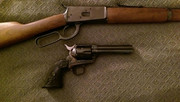First, a new proprietary patented bullet from Grizzly Cartridge was tested. The bullet is a machined brass projectile with a huge hollow point, however the "hole" is actually a hexagon. The angles of the hexagon are cut deep into the brass towards the outside. The projectiles are light for caliber so they can be pushed pretty fast. Upon impact the hexagon breaks into 6 secondary projectiles causing ancillary wound channels. These are not dangerous game loads but are rather intended to knock down medium sized animals in their tracks. They were supposed to be CA legal to be used for hogs and elk and bear, but the 1.58% lead content to make the brass machinable exceeded the CA 1% rule and they failed to be approved in their current form. Grizzly is working on getting them CA legal. I think they are called the "Hex-olid Rocket". Here's a photo of a 45-70, which comes in 300 grain. Upon impact the 6 hexagon pieces that break off weigh 15 gr each. The 50 cal bullets weigh 350 grs. Nopt a great photo but you can see the hexagon hollow point if you look closely.

Jake shot a 4 1/2 yr old bison with a Marlin 1895 22" barrel in 45-70. He was using the Hex-olid Rocket bullet at 2350 fps. The bull received a shot at 52 yards that pierced the back of the shoulder muscle, cut through the lungs and broke the off-side shoulder. The ancillaries cut the jugular and windpipe. The bull did 180 and took a second shot between the first and second ribs and slightly high. The bullet went through both lungs and lodged under the hide on the opposite side. Keep in mind these bullets are not really meant for an animal this big. Both recovered bullets weighed the same 210 grains each.
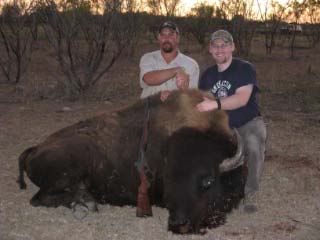
The next animal may just be the largest we've ever killed on the ranch. This 7 yr old Longhorn bull weighed 2880 pounds! The first shot from young Zach's 30-06 was a 240gr Woodleigh Buffalo Bullet at 2450 fps. This bullet was specifically designed by Woodleigh for culling water buffalo, feral cattle and camels. The shot hit low and broke the leg bone before cutting through one lung and lodging in the other. The distance was 75 yards. The bull went 50 yards and fell over. It was not dead but it was imobilized. The bullet was later found to weigh 186 grains and overall penetration was around 12.5". The bull was then shot with a 30-30 Winchester 94, 20" barrel. The loading was a 170 gr Hawk at 2210 fps. Three quick shots just behind the front leg at 25 yards were fired in hopes that it would be enough to do the job. All of the bullets were found just 7 inches into the bull and each shed the jacket and mushroomed nearly flat. In order to expedite death as just over 1 minute had passed since the first shot, a 50 Alaskan was used sending two 350 grain Hex-olid Rocket bullets into the bulls shoulder from 30 yds. The 50 cal bullets penetrated 18" and lodged inside the shoulder on the off-side. The secondary projectiles from the hexagon were found to have cut into the liver, spleen and stomach as well as the lungs. The pieces went in a circular pattern up to 10 inches from the intitial bullet path.
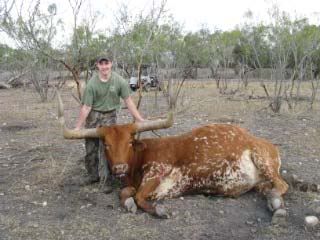
The oldest girl on this trip, (second elder girl in the family) used a 30-06 with a 220 grain Kodiak bullet flying at 2540 fps to take a medium sized elk. Her 88 yard shot hit the center of the shoulder. The bull went 10 yards in broken hops and went down. It expired about a half minute later. The bullet was recovered and it expanded to .46 caliber with approximately 30 inches of penetration. It broke leg bone, penetrated vitals, broke a rib lodged under the hide.
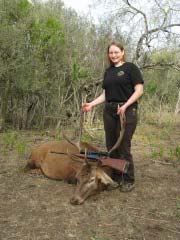
The next sister in decending age order used a 444 Marlin caliber and rifle. Her ammunition was a 300 grain Swift A-Frame at just short of 2300 fps. She decided to take a year and a half old Watusi. We spent 3 or 4 hours walkiing the ranch to find this animal and then another 2 hours getting close enough for a shot. Her first shot hit the side of the face and exited behind the jaw. The distance was 70 yds. I was wondering what happened but she quickly told me she intentionally took a head shot but was a little low of between-the-eyes. Unfortunatley we spent an hour tracking the Watusi to locate it again. This time at 72 yards on my Leica rangefinder Samantha hit the Watusi between the eyes. The bullet exited the back of the head and re-entered the animal through the neck. Overall, the bullet went through 22 1/2" of skin, bone and flesh. It expanded to .58" and lost only 77 grains.
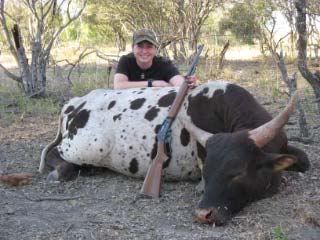
Next the eldest boy, Peter was up with the 444 Marlin. He chose a 265 grain Swift A- Frame followed by 230 grain Hex-olid Rocket bullets. He picked out a three yr old 6X6 elk that finally stood broadside in the brush at 90 yards. The first shot went though the shoulders and exited. The bull swaped ends and Peter quickly worked the action and let another bullet go. The brass Hex-olid Rocket hit the middle of the shoulder and blew the lungs to bits, dropping the elk on the spot. The solid part of the bullet went under the hide on the opposite side and travelled around 16", losing 72 grains of weight.
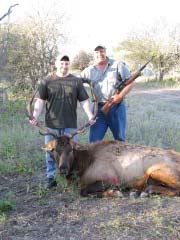
The youngest girl on the safari was Kate who chose a 30-06 to take a Yak. She chose to take a between-the-eyes head shot with the 220gr Kodiak bullet. Her animal was the only one to drop on the spot stone dead out of everything shot this week. The shot was taken at 46 yards and it went though the head and travelled 12 inches down the neck. It weighed 176 grains and measured .42 caliber.

A record book sized Black Hawaiian Ram attracted Peters attention so he grabbed the 30-06 and we went after it. At 100 yards he made a perfect heart shot. The bullet went though the ram and sent bark flying from the tree behind it. The ram ran 55 yards and skid to a stop. The heart could not be readily identified upon looking inside the animal during skinning and cleaning. The ram easily made the Exotic Book of Records.
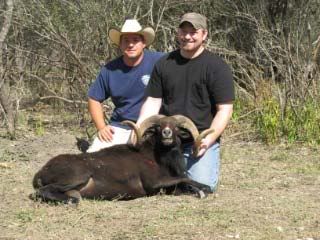
A fairly new Winchester 71 in (of course) 348 Win begged to hunt. Hardly a challenge for this caliber/rifle combination, a Mouflon ram was targeted. This ram was acting weird and I wanted to take it off the ranch so I dropped the otherwise hefty price of $2500 by 4/5th. A head on shot at 90 yards sent a 250 grain Kodiak bullet at 2390 fps through the neck breaking the bone, through the right lung, along the right ribs and out the left pelvic center. Believe it or not the ram hopped into the brush, rolled around, attempted to get up and finally flopped dead about 12 yards from where it took the shot.
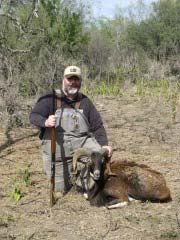
My friend Art came by and told me he had been seeing a free ranging Sika deer buck in his cow pasture for the past several days. We hunted two days but it didn't show. We decided to give it one more whirl on the last afternoon. The buck hopped the 3 strand bobbed-wire and strutted out into the hay. Peter sent a 220 grain .30 cal Kodiak through his shoulders penetrating both lungs and exiting. The shot was 160 yds. The deer spun around a few times, then fell dead. It would have been an 8 pt. but one point was broken off the right entirely and the second tine on the left was broken half way off.
"No picture yet"
We then piled up some carcasses and hides to test other bullets. The 44 Special 240grain Swift A- Frames were clocked at 823 fps average from my 2 1/2" revolver. The bullets penetrate 9 inches of raw flesh with no bone contact from 12 yds. They expand to right around .55 cal and lost only 45 grains. 45-70 Kodiaks weighing 350 grain and travelling 2250 fps penetrated 28" of flesh average from 50 yds and expand to .70 or more. The 405 gr Kodiaks from 45-70 fired at 2050 fps from 50 yds into flesh penetated 28 inches also but they expanded to .90. 38 Super 147 grain Golden Sabre at 1255 gps from a Colt autoloader penetrated 15" of raw flesh from 12 yds and expanded to .45 diameter average.
Overall, it was a great time, hunt and test! The live weight total was right at 10,000 pounds and the meat they took home was 3545 pounds de-boned. They pulled a 21ft trailer with 3 full sized chest freezers and a generator to power them (plus some dry ice). Their meat made it home and is reported to be delicious with no exceptions. The trophies will keep the taxidermist busy for the next 6 months.

